Removal Procedure
Tools Required
| • | J 24402-A Glass
Sealant (Cold Knife) Remover |
| • | J 39032 Stationary
Glass Removal Tool |
| • | Cartridge-type caulking gun |
| • | Commercial-type utility knife |
- Apply masking tape around to the surfaces around the stationary
window in order to prevent damage to the paint and headliner.
- Remove the windshield wiper arms. Refer to Wiper Arm Replacement
in Wipers/Washer Systems.
- Remove the antenna, if equipped. Refer to Fixed Antenna Replacement
.
- Open the hood.
- Remove the air inlet grille. Refer to Air Inlet
Grille Panel Replacement
in Body Front End.
- Remove the inside rearview mirror. Refer to Rearview Mirror Replacement
.
Caution: If broken glass falls into the defroster outlets, it can be blown into
the passenger compartment and cause personal injury.
- Cover the defroster grille outlets and protect the headliner as needed..
- Remove the door sealing weather strip from the upper pinchweld
flange.
- Remove the screws that retain the windshield frame filler panels.
- Remove the frame filler panels.
Caution: When working with any type of glass or sheet metal with exposed or rough
edges, wear approved safety glasses and gloves in order to reduce
the chance of personal injury.
Important: The windshield reveal molding fills the cavities between the body and
windshield and can not be reused if stretched or damaged.

- Remove the windshield
reveal molding.
| 11.1. | Grasp the lower corner of the windshield reveal molding by hand
and slowly pull the reveal molding away from the windshield. |
| 11.2. | If the windshield reveal molding will not release, use a utility
knife in order to cut around the windshield in order to remove the windshield
reveal molding. |

- Remove the lower windshield supports (1) from the cowl panel, if equipped.

Important: Keep the cutting edge of the tool against the windshield when removing.
This will allow the urethane adhesive to be separated from the windshield
and leave a base of urethane on the pinchweld flange. The only suitable
lubrication is clear water.
- Use the J 24402-A
or J 39032
tool in order
to remove the windshield.

- Remove the windshield
from the vehicle with the aid of an assistant.
- The following components may reveal the causes of a broken windshield:
| • | The flange of the windshield opening |
| • | The windshield reveal molding |
- Inspect for any of the following problems in order to help prevent
future breakage of the windshield:
| • | Hardened spot weld sealer |
| • | Any other obstruction or irregularity in the pinchweld flange. |
| | Important: If corrosion of the pinchweld flange is present, or if sheet metal repairs
or replacements are required, the pinchweld flange must be refinished in order
to restore the bonding area strength. If paint repairs are required,
mask the flange bonding area prior to applying the color coat in order
to provide a clean primer only surface. Materials such as BASF DE17 ®,
DuPont 2610 ®, Sherwin-Williams PSE 4600 and
NP70 ® and Martin-Semour 5120 and 5130 ® products
are approved for this application.
|
| • | After repairing the opening as indicated, perform the following steps: |
| • | Remove no more of the urethane adhesive from the pinchweld than
necessary in order to maintain the original shape. This will ensure the proper
clearance between the windshield and the pinchweld flange. |
| • | Remove all traces of broken glass from the outer cowl panel, seats,
floor and defroster ducts. |
| • | Clean around the edge of the inside surface of the windshield
with a 50/50 mixture of isopropyl alcohol and water by volume on a dampened
lint free cloth. |
Installation Procedure
Caution: When replacing stationary windows, use Urethane Adhesive Kit GM P/N 12346392
(Canadian P/N 10952983), or a urethane adhesive system meeting GM Specification
GM3651G, to maintain original installation integrity. Failure to use the urethane
adhesive kit will result in poor retention of the window which may allow unrestrained
occupants to be ejected from the vehicle resulting in personal injury.
After repairing the opening as indicated, perform the
following:
- Shake the pinchweld primer (black #3) for at least one
minute.
Caution: Failure to prep the area prior to the application of primer
may cause insufficient bonding of urethane adhesive. Insufficient bonding
of urethane adhesive may allow unrestrained occupants to be ejected from
the vehicle resulting in personal injury.
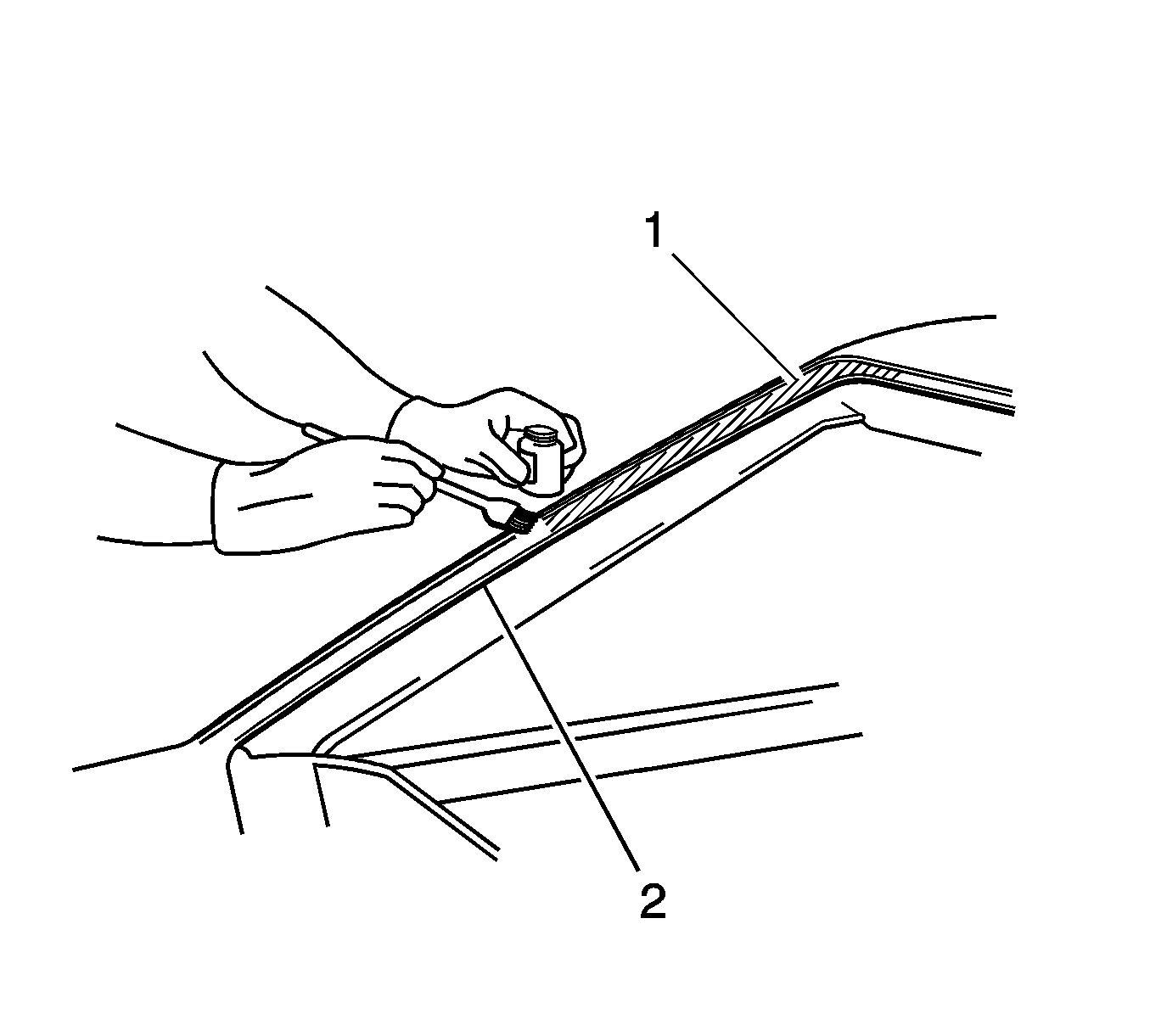
- Use a new dauber to apply
the pinchweld primed (black #3) to the surface (1) of the bonding area.
- Allow the primer to dry for approximately 10 minutes. Ensure that
all nicks and scratches are covered.

- Install the lower windshield supports (1) to the cowl panel, if equipped.

- Install the spacers and
the VIN plate filler strip if using the extended method.

- Install the reveal molding
to the edge of the windshield. If the original reveal molding is damaged
it must be replaced.
- Install a new acoustic strip if needed.

- With the aid of an assistant,
dry fit the windshield in the opening in order to determine the correct way
to position the windshield in the opening.

- Use masking tape (1) in
order to mark the location of the windshield in the opening.
- Slit the masking tape at the top edge of the windshield.
- With the aid of an assistant, use suction cups to remove the windshield
from the opening.
- Place the windshield inside up on a clean, protected surface.
- If the original windshield is being reused remove all but a thin
film of the existing urethane adhesive from the windshield surface by using
a clean utility knife or razor blade scraper.
- Clean around the edge of the inside surface of the windshield
with a 50/50 mixture of isopropyl alcohol and water by volume on a dampened
lint free cloth.
- If the extended method is being used remove all but approximately
2 mm (3/64 in) of the existing bead of adhesive from the pinchweld
flange.
Important: Do not remove all traces of the adhesive. Remove all mounds or loose
pieces of urethane adhesive.
- Shake the pinchweld primer (black #3) for at least one minute.
- Use a new dauber to apply the primer to the surface of the pinchweld
flange.
- Allow the pinchweld primer to dry for approximately 10
minutes.
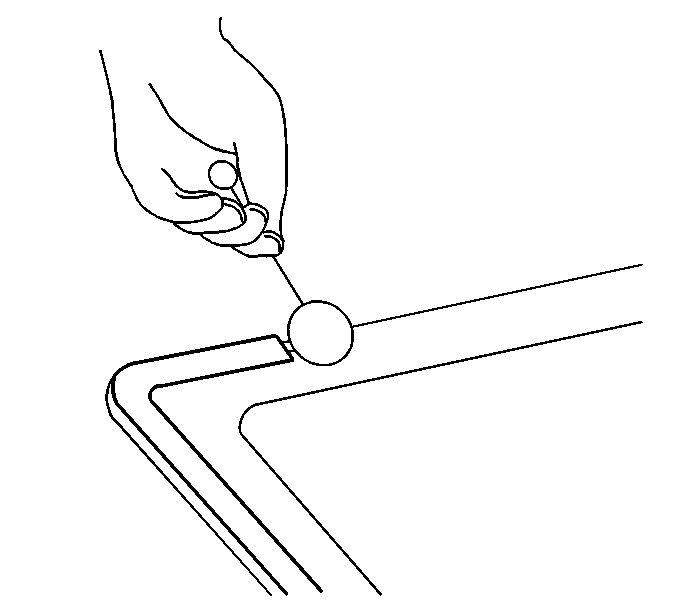
Important: Use care when applying the glass prep (clear #1) in order to
prevent the windshield prep from running into the vision area of the windshield.
This primer dries almost instantly, and may stain the viewing
area of the windshield if not applied evenly.
- Use a new dauber in order to apply glass prep (clear #3) to the
area approximately 10 mm to 16 mm (3/8 in to 5/8 in).
around the entire perimeter of the window inner surface.
- Apply a second coat of the glass prep number (clear #1)
to the same area of the glass.
- Wipe the primed glass area immediately with a clean lint free
cloth.
- Shake the glass primer (black #2) for at least one minute.
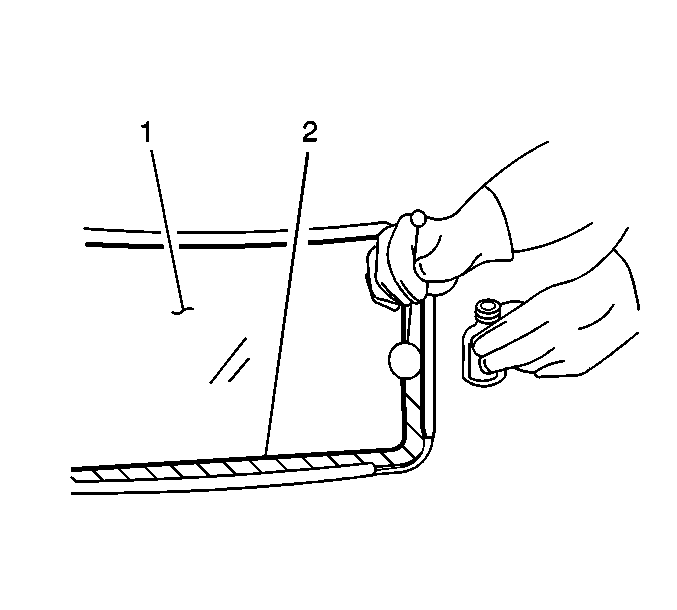
- Use a new dauber in order
to apply the glass primer (black #2) to the same areas (2) that glass
prep (clear #1) was applied.
The glass primer (black #2) is good up to 8 hours after applying
it to the glass. The primed surface of the glass must be kept clean.
- Allow the glass primer to dry for approximately 10 minutes.
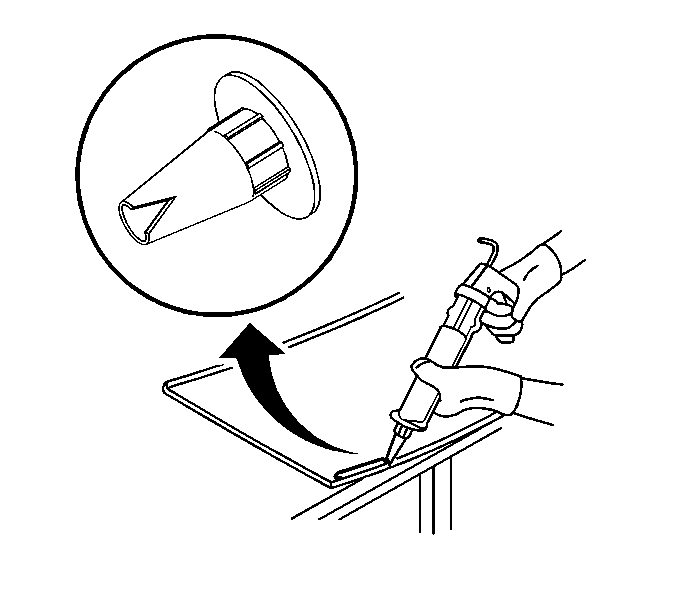
- Cut the tip of the applicator
nozzle as follows:
| 25.1. | If using the short method, cut the tip of the applicator nozzle
in order to provide a bead of 6.0 mm (1/4 in). |
| 25.2. | If using the extended method, cut the applicator nozzle in order
to provide a bead of 12.7 mm (1/2 in) wide and 12.7 mm
(1/2 in ) high. |
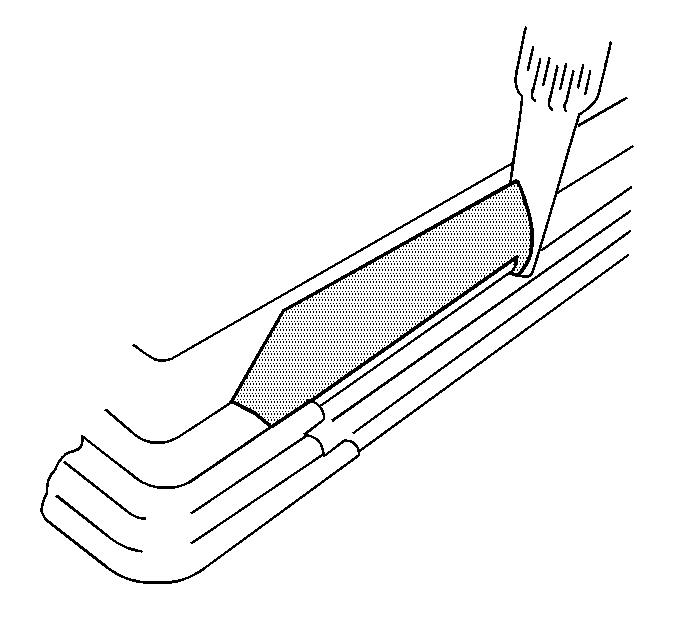
- Use a cartridge type caulking
gun to apply a smooth, continuous bead of urethane adhesive.
- If reusing the original glass apply the new urethane adhesive
on the top of the fresh trimmed urethane adhesive.
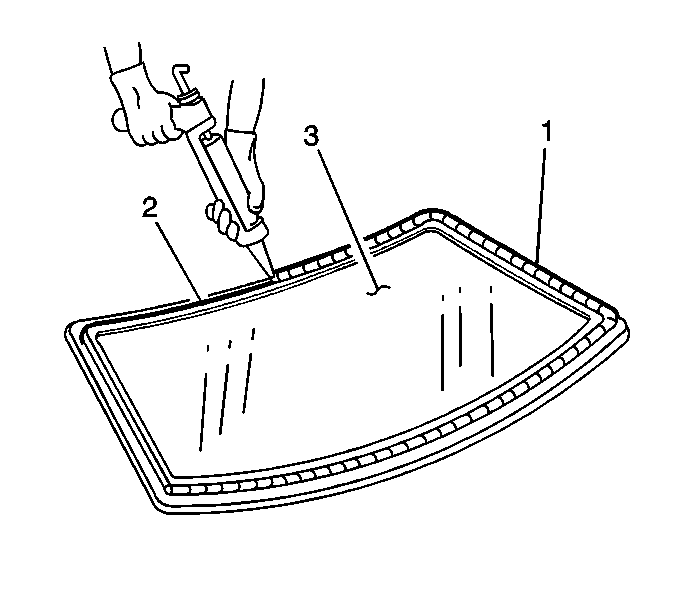
- When using the extended
method do the following, use the edge of the windshield window or the inside
edge of the reveal molding as a guide for the nozzle in order to apply the
urethane adhesive (1) to the inner surface of the windshield window. (3).
If applying urethane adhesive to the inside edge of the windshield reveal
molding (1) use the windshield reveal molding as a guide for the nozzle.

- With the aid of an assistan,
use suction cups to install the windshield into the opening.

- Place the windshield on the lower supports.

- Align the tape (1) lines
on the windshield and the body.
- Press the windshield firmly into place.
- Tape the windshield to the body in order to minimize movement
until the urethane adhesive cures.
- Clean any excess urethane adhesive from the body.
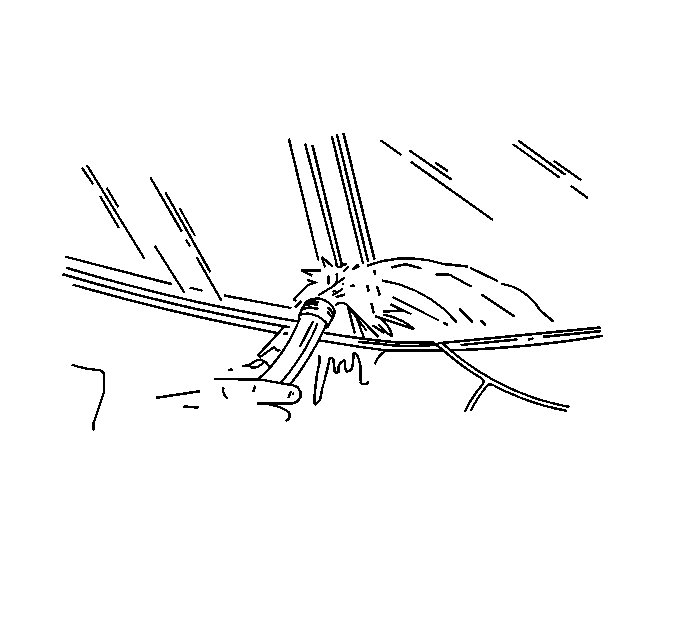
Important: Do not direct a hard stream of high pressure water to the freshly applied
urethane adhesive.
- Use a soft spray of warm water in order to water test the windshield
immediately.
- Inspect the windshield for leaks.
- If any leaks are found, use a plastic paddle in order to apply
extra urethane adhesive at the leak point.
- Retest the windshield for leaks.
Caution: At least 24 hours are required for complete curing of repair
material. The repair area should not be physically distrubed until after that
time. Insufficient curing of urethane adhesive may allow unrestrained occupants
to be ejected from the vehicle resulting in personal injury.
- The following conditions must be maintained to properly cure the urethane:
| • | Allow the vehicle to remain at room temperature (21°C or 70°F)
at 30 percent relative humidity. |
| • | Allow a minimum of 6 hours for the moisture curing urethane
adhesive. |
| • | Allow a minimum of 1 hour to 1 1/2 hours for the chemical
curing urethane adhesive. |
| • | Partially lower a door window in order to prevent pressure buildups
when closing doors before the urethane adhesive cures. |
| • | Do not drive the vehicle until the urethane adhesive is fully
cured. |
| • | Do not use compressed air in order to dry the urethane adhesive. |
Notice: Use the correct fastener in the correct location. Replacement fasteners
must be the correct part number for that application. Fasteners requiring
replacement or fasteners requiring the use of thread locking compound or sealant
are identified in the service procedure. Do not use paints, lubricants, or
corrosion inhibitors on fasteners or fastener joint surfaces unless specified.
These coatings affect fastener torque and joint clamping force and may damage
the fastener. Use the correct tightening sequence and specifications when
installing fasteners in order to avoid damage to parts and systems.
- Install the windshield
side reveal molding screws.
Tighten
Tighten the windshield side reveal screws to 2 N·m(18 lb in).
- Install the windshield frame filler panel with two screws.
Tighten
Tighten the windshield frame filler panel screws to 2 N·m(18 lb in).
- Install the door sealing weatherstrip to the upper pinchweld flange.
- Install the inside rearview mirror. Refer to Rearview Mirror Replacement
.
- Install the air inlet grille. Refer to Air
Inlet Grille Panel Replacement
in Body Front End.
- Close the hood.
- Install the antenna, if equipped. Fixed Antenna
Replacement
.
- Install the windshield wiper arms. Refer to Wiper Arm Replacement
in Wiper/Washer System.
- Remove the protective coverings and tape from the vehicle.



















